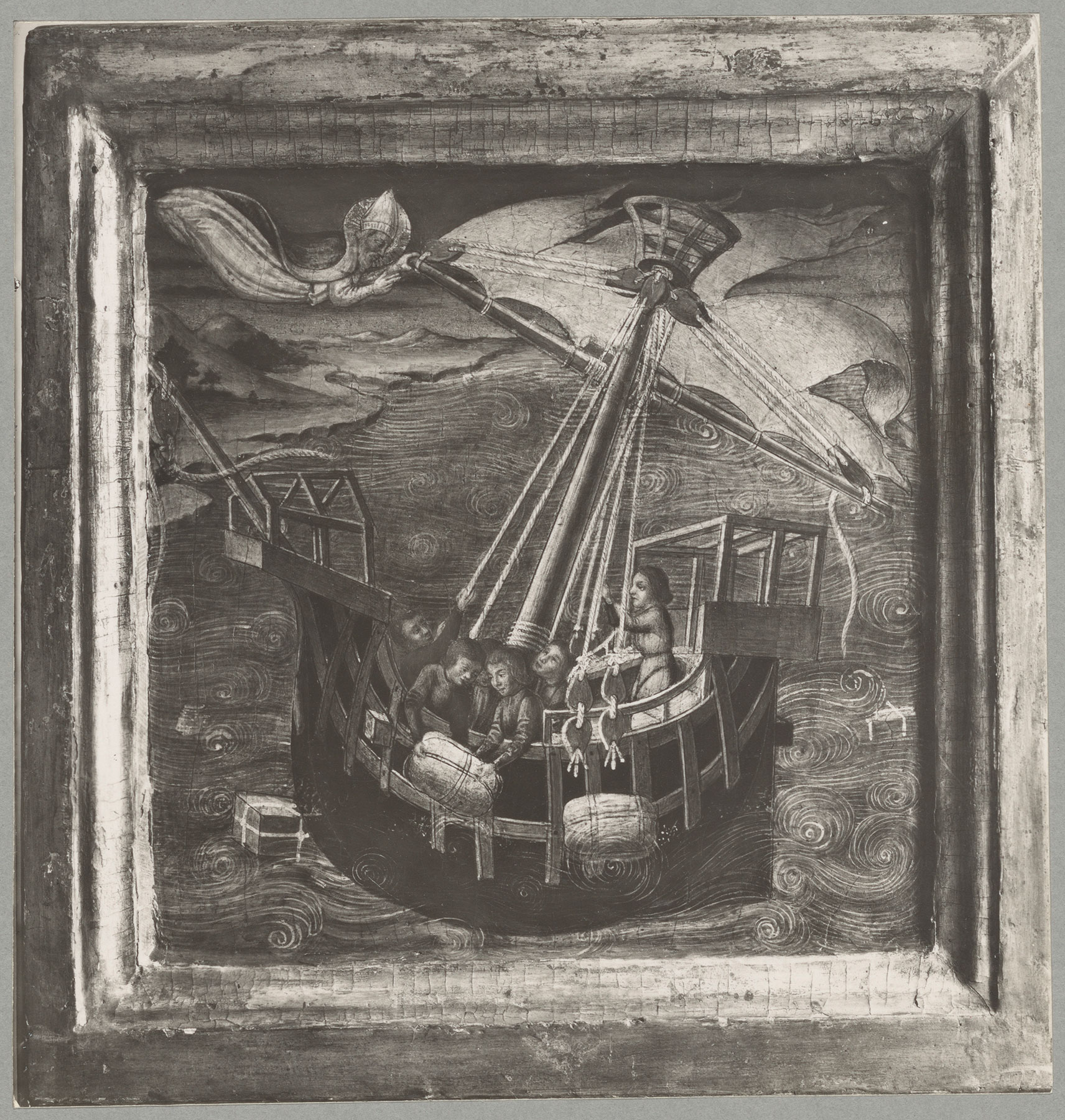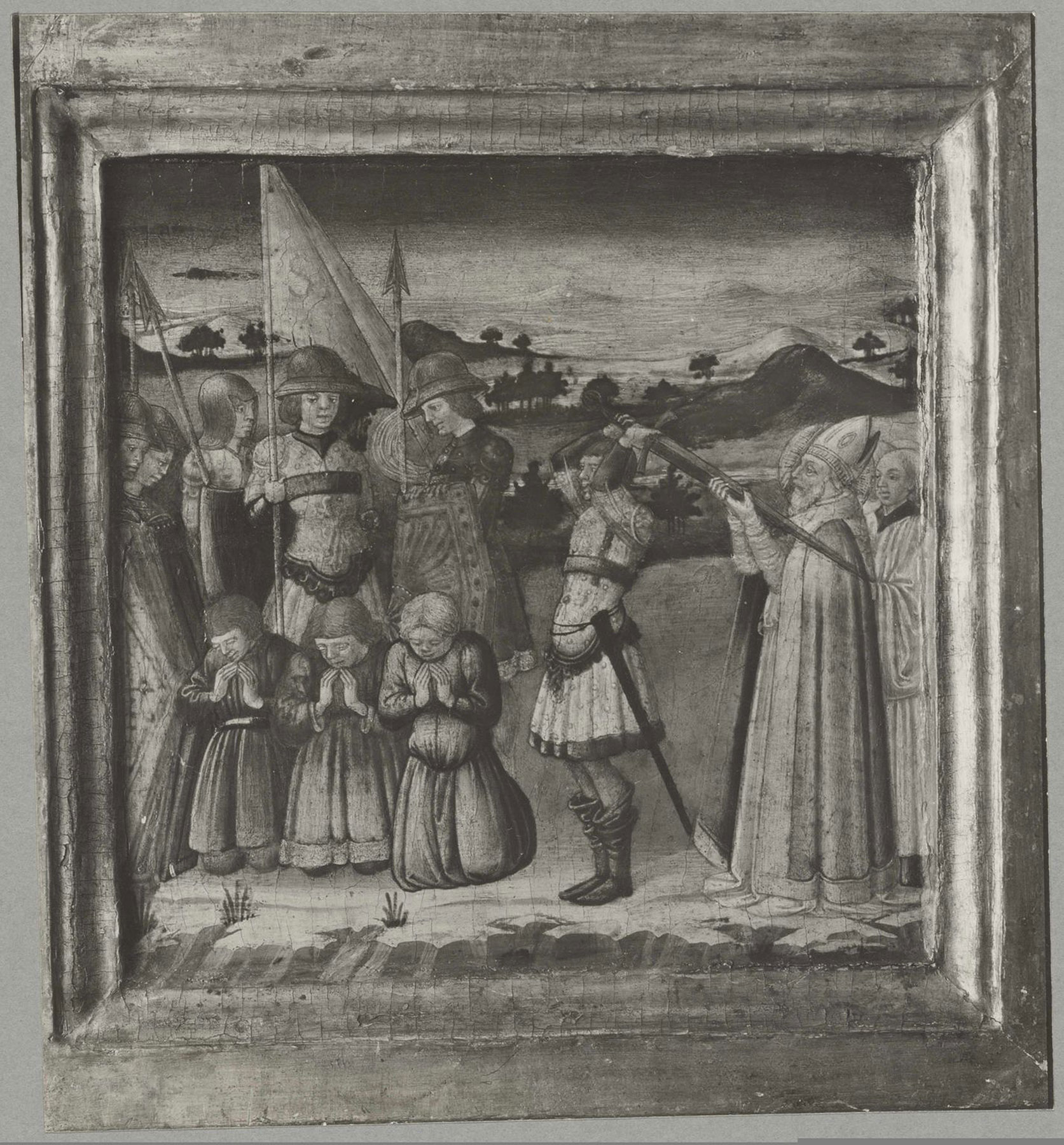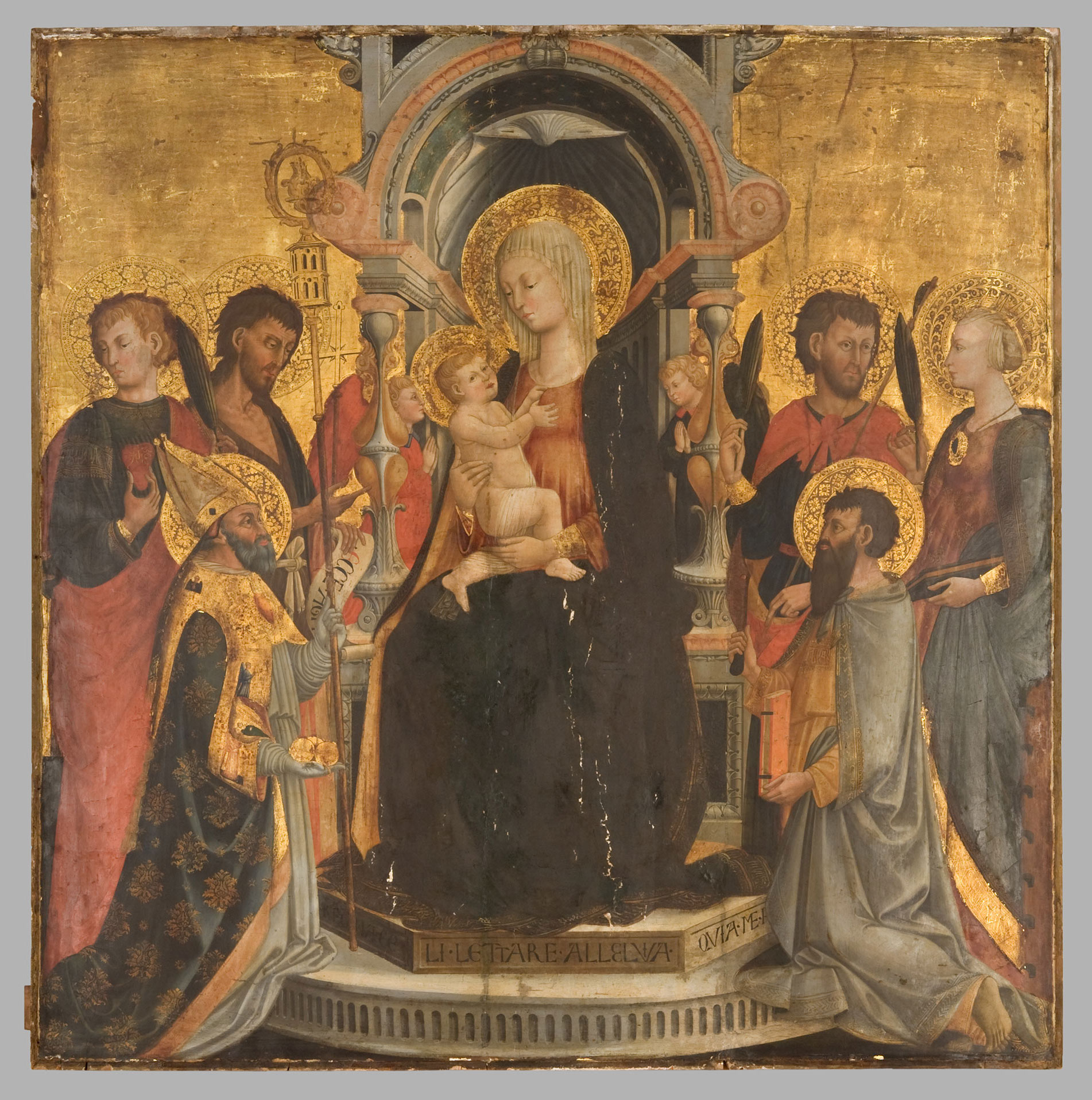James Jackson Jarves (1818–1888), Florence, by 1859
The panel, of a horizontal grain, is 1.5 centimeters thick. It was cradled and waxed by Charles Durham at the Fogg Museum, Harvard University, Cambridge, Massachusetts, in 1928 and cleaned again by Andrew Petryn in 1952. The present engaged frame is modern. The paint surface has been evenly abraded and the faces of all the figures retouched. Paint loss is otherwise minimal.
The story of the charity of Saint Nicholas of Bari, shortly preceding his investiture as bishop of Myra, is recounted in the Golden Legend of Jacobus de Voragine:
After the death of his parents [Nicholas] began to consider how he might make use of his great wealth, not in order to win men’s praise but to give glory to God. At the time a certain fellow townsman of his, a man of noble origin but very poor, was thinking of prostituting his three virgin daughters in order to make a living out of this vile transaction. When the saint learned of this, abhorring the crime he wrapped a quantity of gold in a cloth and, under cover of darkness, threw it through a window of the other man’s house and withdrew unseen. Rising in the morning, the man found the gold, gave thanks to God, and celebrated the wedding of his eldest daughter. Not long thereafter the servant of God did the same thing again. . . . Some little time later Nicholas threw a double sum of gold into the house.1
Neri di Bicci has conflated the successive moments of the story into a single emblematic image. At the left, the young and expensively dressed saint—his fashionable red tunic hemmed in ermine—stretches on his toes to throw a ball of gold through the window of the impoverished nobleman’s house. Inside are two balls of gold already lying on the ground, as though all three had been bestowed at once. The nobleman, dressed in blue at the right, and his eldest daughter look down at the gold in surprise and gratitude, suggesting their having risen in the morning (also implied by the light in the blue sky at the far left), as described in the text. The other two daughters remain asleep, one sitting on a low stool and the other on the ground alongside her father’s bed, presumably to underscore the family’s penury as well as to set the scene of the charity at night.
Since its first publication by James Jackson Jarves in the 1860 catalogue of his collection, the Charity of Saint Nicholas of Bari has been recognized as a typical work by Neri di Bicci.2 Jarves did remark that “on account of the archaic character of this little painting, several critics attribute it to Cimabue, to whose figures these bear considerable resemblance in design”; this eccentric observation appears nowhere else in print. For William Rankin, the Charity was an “insignificant panel,”3 while Osvald Sirén thought it “one of Neri di Bicci’s most refined and attractive creations.”4 It elicited little more than acknowledgment of its existence in subsequent references to it. A note on the photograph of the painting in the Frick Art Reference Library, New York, records that, in 1941, Jan Leyda associated it with two panels of similar size formerly in the Toscanelli collection at Pontedera, near Pisa, showing further miracles of Saint Nicholas: Saint Nicholas Calming a Tempest at Sea (fig. 1) and Saint Nicholas Preventing the Execution of Three Innocent Soldiers (fig. 2).5 The reconstruction of these three panels as fragments of a single predella was repeated in 1970 by Charles Seymour, Jr.,6 who, however, did not mention a second opinion recorded in 1965 at the Frick Art Reference Library that the predella might have stood beneath a triptych by Neri di Bicci in the church of San Lorenzo a Miransù at Rignano sull’Arno, near Florence (now Villa di Castiglionchio, Pontassieve), showing the Virgin and Child Enthroned with Saints Nicholas of Bari and Lawrence.


The San Lorenzo a Miransù triptych is scarcely large enough to have counted three scenes from the legend of Saint Nicholas of Bari among its predella panels, especially if a corresponding number of scenes from the legend of Saint Lawrence, patron of the church, once accompanied them. Even more difficult to reconcile is the style of the works. The triptych is painted in Neri’s earliest style, before he assumed the direction of his father’s workshop, and has reasonably been dated between 1447 and 1453.7 The Yale panel and its companions formerly in the Toscanelli collection (all the figures in the tempest scene, except Saint Nicholas at the top, have been repainted and cannot be judged stylistically) are somewhat later works, easily recognizable as Neri di Bicci free from most of the influence of Bicci di Lorenzo. It is far more likely that a series of entries in Neri’s account books, the Ricordanze, might relate to the commission of which they were part. On April 26, 1456, six citizens of Poggibonsi, a town in the Valdelsa near the border between the Florentine and Sienese territories, ordered an altarpiece from Neri di Bicci for the chapel of the Confraternity of San Niccolò in their parish church. The altarpiece—for which the parties agreed upon a price of 260 lire—was to be three braccia (roughly 175 cm) square; with its frame, cornice, and predella, it was to measure 3 5/6 braccia (224 cm) wide and 5 braccia (290 cm) tall. It was to portray the Virgin and Child with two or three saints on either side; the identities of the saints were unspecified. The predella was to show three stories of Saint Nicholas of Bari with an image of two flagellants at either end.8 Neri ordered the panel and frame for this altarpiece from Giuliano da Majano on May 26, 1456. Having shown Giuliano a drawing of what he wanted, Giuliano asked for a payment of 60 lire, and Neri offered him 50.9 A year later, on April 14, 1457, Neri’s work must have been complete as he renegotiated the price of the altarpiece at 280 lire to cover his increased costs.10
The lack of specificity in the Ricordanze in naming the saints accompanying the Virgin and Child in the Poggibonsi altarpiece has so far frustrated attempts to identify it. One surviving altarpiece, however, is a prime candidate for this “missing” work: a Virgin and Child Enthroned in the Philadelphia Museum of Art (fig. 3). Carl Strehlke has correctly dated this work to ca. 1457 on stylistic grounds and associated it with an entry in the Ricordanze commissioning an altarpiece for the church of Santa Maria alla Canonica in Putignano near Greve, in Chianti.11 That altarpiece, however, was specified as being 4 braccia wide and only 4 2/3 braccia tall, including its frame with cornice and predella; its painted surface would therefore have been wider than it is tall. The Philadelphia panel (165.1 × 163.5 cm) is almost exactly 3 braccia square, the size indicated for the Poggibonsi altarpiece. Among the six saints in the Philadelphia panel, Saint Nicholas occupies the position of honor, kneeling in the foreground on the Virgin’s right. The Virgin turns her regard toward him and seemingly offers him the gift of her Son. If the altarpiece predella was completed by images of confraternity members at either side, as specified in the account book entry, and these were more or less the same size as the Saint Nicholas scenes then, the five compartments would account for a total width of about 155 centimeters—more, if any amount of wood separating the scenes was lost when they were cut apart. While the evidence is not absolutely conclusive, it is probable that the Philadelphia altarpiece along with the Yale Charity of Saint Nicholas and its companion scenes were originally part of the commission from the Confraternity of San Niccolò in Poggibonsi in 1456–57. —LK

Published References
Jarves, James Jackson. Descriptive Catalogue of “Old Masters” Collected by James J. Jarves to Illustrate the History of Painting from A.D. 1200 to the Best Periods of Italian Art. Cambridge, Mass.: H. O. Houghton, 1860., 48–49, no. 53; Sturgis, Russell, Jr. Manual of the Jarves Collection of Early Italian Pictures. New Haven: Yale College, 1868., 60; W. F. Brown, Boston. Catalogue of the Jarves Collection of Early Italian Pictures. Sale cat. November 9, 1871., 543, no. 62; Rankin, William. “Some Early Italian Pictures in the Jarves Collection of the Yale School of Fine Arts at New Haven.” American Journal of Archaeology 10, no. 2 (April–June 1895): 137–51., 147; Sirén, Osvald. A Descriptive Catalogue of the Pictures in the Jarves Collection Belonging to Yale University. New Haven: Yale University Press, 1916., 99–100, no. 39; van Marle, Raimond. The Development of the Italian Schools of Painting. Vol. 10. The Hague: M. Nijhoff, 1928., 543; Berenson, Bernard. Italian Pictures of the Renaissance: A List of the Principal Artists and Their Works with an Index of Places. Oxford: Clarendon, 1932., 388; S[izer], T[heodore]. “The Yale Collection of Early Italian Painting.” Bulletin of the Associates in Fine Arts at Yale University 13, no. 3 (June 1945): 2–4, 7., 4; Comstock, Helen. “The Yale Collection of Italian Paintings.” Connoisseur 118 (September 1946): 45–52., 48–49, no. 5; “Picture Book Number One: Italian Painting,” special issue, Bulletin of the Associates in Fine Arts at Yale University 15, nos. 1–3 (October 1946): n.p., fig. 10; Rediscovered Italian Paintings. Exh. cat. New Haven: Yale University Art Gallery, 1952., 30–31; Berenson, Bernard. Italian Pictures of the Renaissance, A List of the Principal Artists and Their Works with an Index of Places: The Florentine School. 2 vols. London: Phaidon, 1963., 1:156; Seymour, Charles, Jr. Early Italian Paintings in the Yale University Art Gallery. New Haven: Yale University Art Gallery, 1970., 165–66, 317, no. 118; Fredericksen, Burton B., and Federico Zeri. Census of Pre-Nineteenth-Century Italian Paintings in North American Public Collections. Cambridge, Mass.: Harvard University Press, 1972., 599
Notes
-
de Voragine, Jacobus. The Golden Legend. Trans. William Granger Ryan. 2 vols. Princeton, N.J.: Princeton University Press, 1993., 1:21–22. ↩︎
-
Jarves, James Jackson. Descriptive Catalogue of “Old Masters” Collected by James J. Jarves to Illustrate the History of Painting from A.D. 1200 to the Best Periods of Italian Art. Cambridge, Mass.: H. O. Houghton, 1860., 48–49, no. 53. ↩︎
-
Rankin, William. “Some Early Italian Pictures in the Jarves Collection of the Yale School of Fine Arts at New Haven.” American Journal of Archaeology 10, no. 2 (April–June 1895): 137–51., 147. ↩︎
-
Sirén, Osvald. A Descriptive Catalogue of the Pictures in the Jarves Collection Belonging to Yale University. New Haven: Yale University Press, 1916., 100. ↩︎
-
Both measure 23.5 by 23.5 centimeters and are last recorded (1984) in a private collection in Florence. They appeared in the catalogue of the Toscanelli sale (Galleria Sambon, Florence, April 9–23, 1883, lot 65) as Pesellino and are mentioned with that attribution by Raimond van Marle in 1928, but they were recognized by Richard Offner, also in 1928, as by Neri di Bicci; van Marle, in van Marle, Raimond. The Development of the Italian Schools of Painting. Vol. 10. The Hague: M. Nijhoff, 1928., 521n, refered to the second painting only and said it was by a follower of Pesellino. Purchased at the Toscanelli sale by “Zographos” of Athens and from him in 1885 by Joseph Spiridon of Paris, the paintings appeared in the Spiridon sale (Cassirer-Helbing, Berlin, May 31, 1929, lots 21–22) as Florentine school, ca. 1450. In 1944 they were in the collection of Ely Pintsch in Berlin and were offered for sale at Sotheby’s, New York, June 11, 1981, lot 28. ↩︎
-
Seymour, Charles, Jr. Early Italian Paintings in the Yale University Art Gallery. New Haven: Yale University Art Gallery, 1970., 166. ↩︎
-
Venturini, Lisa. “‘Restauri’ quattrocenteschi: Neri di Bicci, Domenico Ghirlandaio.” Kermes: Arte e tecnica del restauro 7 (1994): 28–34., 32, 34n17. For a related but not entirely consonant study of the Miransù triptych, see Thomas, Anabel. “Neri di Bicci: The S. Sisto Crucifixion, the Mantellate Nuns of S. Monaco at Florence and the Compagnia di Miransu.” Antichità viva 32, no. 5 (1993): 5–15., 5–15. ↩︎
-
Santi, Bruno, ed. Neri di Bicci: Le ricordanze. Pisa: Marlin, 1976., 55–56, no. 111. “Portraits” of flagellant confraternity members were commonly included at the ends of predellas in Sienese altarpieces commissioned by companies of disciplinati. See Sano di Pietro’s Adoration of the Magi in the Yale University Art Gallery’s collection: inv. no. 1871.61, https://artgallery.yale.edu/collections/objects/322. ↩︎
-
Santi, Bruno, ed. Neri di Bicci: Le ricordanze. Pisa: Marlin, 1976., 57–58, no. 114. ↩︎
-
Santi, Bruno, ed. Neri di Bicci: Le ricordanze. Pisa: Marlin, 1976., 72–73, no. 143. ↩︎
-
Strehlke, Carl Brandon. Italian Paintings, 1250–1450, in the John G. Johnson Collection and the Philadelphia Museum of Art. Philadelphia: Philadelphia Museum of Art, 2004., 319–23. ↩︎